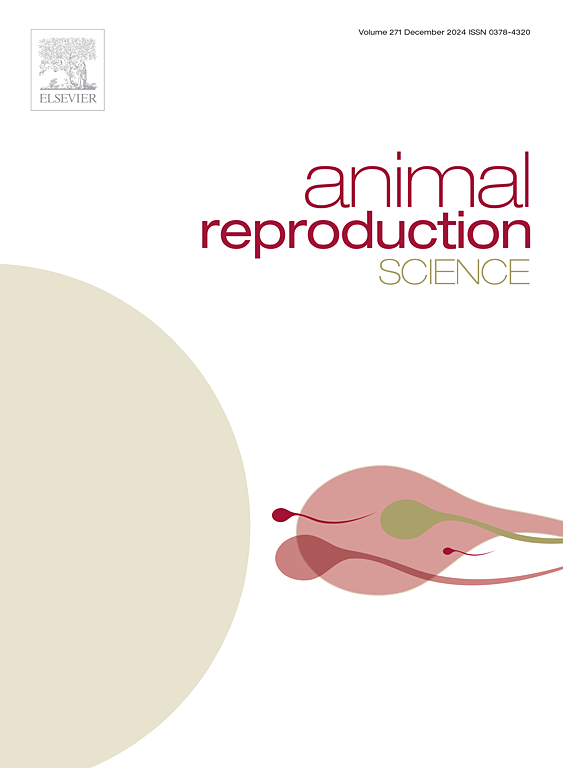Risk factors for Serratia marcescens contamination in liquid preserved boar semen – A cross-laboratory comparative study
IF 3.3
2区 农林科学
Q1 AGRICULTURE, DAIRY & ANIMAL SCIENCE
引用次数: 0
Abstract
Antibiotic-free extenders are being used with increasing frequency in boar artificial insemination (AI) centers to prevent the promotion of antibiotic resistance. In this context, it becomes imperative to ensure hygienic semen production and to conduct regular hygiene checks in semen-processing laboratories (labs). This study presents the spermatological and microbiological findings from hygiene checks at eight German boar AI centers in 2024. At each of the 10 included labs, microbiological samples were taken from nine hygienic critical control points (HCCPs, n = 90), and 15 extended semen doses (n = 150) were examined spermatologically and microbiologically. The bacteria were identified based on matrix-assisted laser desorption ionization-time of flight mass spectrometry. Additionally, antimicrobial susceptibility tests were performed for 13 commonly used antibiotics. In total, 21 different bacterial genera were identified at the HCCPs. Contamination with Serratia marcescens (S. marcescens) was found in three labs. In two labs, the sinks were contaminated and in one lab, the semen dyes were contaminated with S. marcescens. A total of 15 semen doses (10 %) from four AI centers were found to be contaminated with bacteria, 11 contained S. marcescens. The contamination was associated with a decline in sperm quality, characterized by sperm agglutination, and reduced total sperm motility after thermo-resistance test. The antibiogram revealed a resistance of S. marcescens isolates to 9 ± 1 (mean ± SD) of 13 tested antibiotics, particularly gentamicin. Considering the findings, it is recommended that labs prioritize maintaining accurate hygiene in sinks and drains, and that they consider abstaining from the use of semen dyes in AI semen production.
液体保存猪精液中粘质沙雷氏菌污染的危险因素-一项跨实验室比较研究
在猪人工授精(AI)中心越来越频繁地使用无抗生素延长剂,以防止促进抗生素耐药性。在这种情况下,必须确保精液生产的卫生,并在精液加工实验室进行定期卫生检查。本研究介绍了2024年在8个德国猪人工智能中心进行卫生检查的精子学和微生物学结果。在所纳入的10个实验室中,每个实验室从9个卫生关键控制点(hccp, n = 90)采集微生物样本,并对15个延长剂量(n = 150)进行精子学和微生物学检查。采用基质辅助激光解吸电离飞行时间质谱法对细菌进行鉴定。此外,还对13种常用抗生素进行了药敏试验。在hccp中共鉴定出21种不同的细菌属。在三个实验室中发现粘质沙雷氏菌污染。在两个实验室,水槽被污染,在一个实验室,精液染料被粘质葡萄球菌污染。4个人工智能中心的15剂精液(10 %)被细菌污染,其中11剂含有粘质葡萄球菌。污染与精子质量下降有关,其特征是精子凝集,并且在抗热试验后精子总活力降低。抗菌谱显示粘质葡萄球菌对13种抗生素中的9种( ± 1)(平均±SD)耐药,以庆大霉素为主。考虑到这些发现,建议实验室优先考虑保持水槽和排水管的准确卫生,并考虑在人工授精过程中避免使用精液染料。
本文章由计算机程序翻译,如有差异,请以英文原文为准。
求助全文
约1分钟内获得全文
求助全文
来源期刊

Animal Reproduction Science
农林科学-奶制品与动物科学
CiteScore
4.50
自引率
9.10%
发文量
136
审稿时长
54 days
期刊介绍:
Animal Reproduction Science publishes results from studies relating to reproduction and fertility in animals. This includes both fundamental research and applied studies, including management practices that increase our understanding of the biology and manipulation of reproduction. Manuscripts should go into depth in the mechanisms involved in the research reported, rather than a give a mere description of findings. The focus is on animals that are useful to humans including food- and fibre-producing; companion/recreational; captive; and endangered species including zoo animals, but excluding laboratory animals unless the results of the study provide new information that impacts the basic understanding of the biology or manipulation of reproduction.
The journal''s scope includes the study of reproductive physiology and endocrinology, reproductive cycles, natural and artificial control of reproduction, preservation and use of gametes and embryos, pregnancy and parturition, infertility and sterility, diagnostic and therapeutic techniques.
The Editorial Board of Animal Reproduction Science has decided not to publish papers in which there is an exclusive examination of the in vitro development of oocytes and embryos; however, there will be consideration of papers that include in vitro studies where the source of the oocytes and/or development of the embryos beyond the blastocyst stage is part of the experimental design.
 求助内容:
求助内容: 应助结果提醒方式:
应助结果提醒方式:


